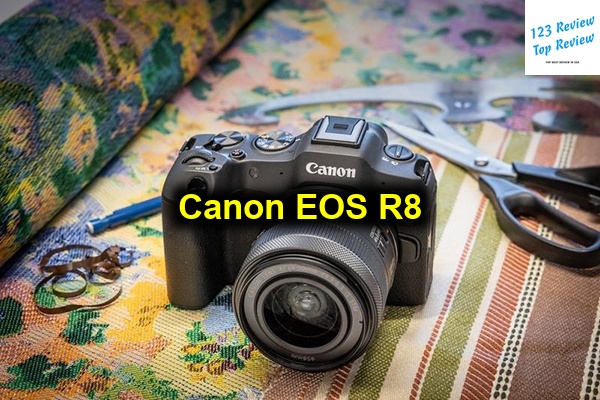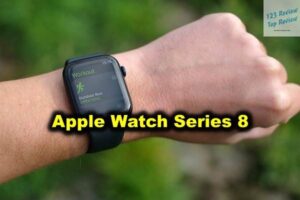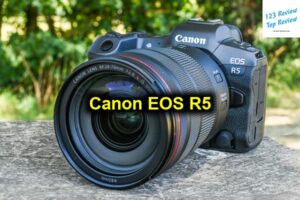The Canon EOS R8 stands as a significant entry in Canon’s evolving lineup of full-frame mirrorless cameras, blending advanced technology with user-friendly features to cater to both enthusiasts and professionals. It strikes an impressive balance between performance and portability, making it an attractive choice for photographers and videographers across various genres.

In this article, 123 Review explores the design and build quality, specifications, performance characteristics, usability, and how the EOS R8 stacks up against its competitors.
Design and Build Quality
Compact and Lightweight Form Factor
One of the most appealing aspects of the Canon EOS R8 is its compact and lightweight form factor. Weighing approximately 461 grams (about 1.02 pounds) with the battery and memory card, the EOS R8 is designed with portability in mind. Its dimensions of approximately 132.5 x 86.1 x 70.0 mm (5.21 x 3.39 x 2.76 in) make it easy to carry, whether you’re on a photography excursion or shooting a spontaneous event.
This lightweight design sets it apart from larger full-frame cameras, allowing users to shoot for extended periods without discomfort. The compact size also facilitates travel—an essential factor for landscape photographers and content creators who need a reliable camera without added bulk.
Ergonomic Handling and Comfort
The Canon EOS R8 excels in ergonomics, designed for comfortable handling. Its grip is well-contoured, allowing for secure and comfortable use, which is particularly important during long shooting sessions. The layout of the controls is intuitive, with buttons and dials strategically placed for quick access to essential settings.
The camera’s design includes a dedicated mode dial, customizable function buttons, and a well-designed rear control wheel, providing tactile feedback that photographers appreciate. Whether you’re adjusting exposure settings or switching shooting modes, the R8 ensures a seamless experience. Coupled with its good balance, even with larger lenses, the EOS R8 proves adept in various shooting scenarios.
Construction Materials and Durability
While the Canon EOS R8 is lightweight, it doesn’t compromise on durability. Constructed with robust materials, the camera features a magnesium alloy body designed to withstand the rigors of professional use. Its weather-sealed design offers protection against dust and moisture, making it a reliable choice for outdoor photography in various environments.
This construction ensures that the camera can perform reliably in demanding conditions—be it a light drizzle during an outdoor shoot or dusty environments typically encountered in travel photography. Canon’s focus on quality and durability is evident in the R8, inspiring confidence in its long-term reliability.
Key Specifications and Features
Sensor and Image Quality
At the heart of the Canon EOS R8 lies a 24.2-megapixel full-frame CMOS sensor. This sensor excels in delivering stunning image quality with rich detail and vibrant colors, providing a significant step up from crop-sensor cameras. The R8’s sensor combined with Canon’s DIGIC X image processor enhances performance, ensuring quick shooting speeds while maintaining superb image fidelity.
The EOS R8’s dynamic range allows for impressive tonal variations, making it suitable for a range of shooting situations, from bright sunlight to dimly lit interiors. Photographers will appreciate the flexibility offered by the ISO range of 100–102400, enabling low-light shooting without significant noise. Output files, whether in JPEG or RAW format, demonstrate a remarkable retention of detail, making post-processing easier and more effective.
Autofocus Performance and Capabilities
Autofocus performance is one of the standout features of the Canon EOS R8. It utilizes Canon’s Dual Pixel CMOS AF II system, which provides fast and reliable autofocus across virtually the entire frame. The R8 boasts 1,053 AF points that cover 100% of the frame horizontally and vertically, ensuring precise focus even in challenging situations.
The camera’s eye and face detection capabilities are particularly noteworthy, allowing photographers to lock onto subjects effortlessly. This makes the R8 an excellent choice for portrait photography, as it can ensure sharp focus on the subject’s eyes, a critical element in creating engaging and emotionally resonant photographs.
Additionally, the R8 offers advanced subject tracking features that enable it to follow moving subjects with impressive accuracy, making it suitable for sports, wildlife, and event photography where quick focus adjustments are essential.
Video Recording Features
For videographers, the Canon EOS R8 does not disappoint. It supports 4K video recording at up to 60p in full-frame mode, enabling creators to capture stunning high-resolution footage. The option to shoot in 10-bit 4:2:2 Canon Log provides added versatility in post-production, allowing for expansive color grading possibilities.
The camera also offers Full HD recording up to 180 fps for slow-motion footage, allowing filmmakers to capture fast action in striking detail. With built-in digital image stabilization, the R8 minimizes camera shake, ensuring smooth footage even when shooting handheld.
Furthermore, the R8 features a clean HDMI output, making it easy to connect to external monitors or stream directly from the camera. This combination of video capabilities positions the EOS R8 as a powerful tool for content creators looking to produce professional-grade video projects.
Usability and User Interface
Controls and Menus
The usability of the Canon EOS R8 is enhanced by its well-thought-out control layout and intuitive menus. The mode dial on the top of the camera provides quick access to common shooting modes, including manual, aperture priority, and scene modes. This simplicity helps beginners start shooting without feeling overwhelmed.
The menu system is organized logically, with clear headings and quick navigation that can be customized to suit individual preferences. Customizable function buttons allow users to assign their most-used settings, streamlining the shooting process and enabling rapid adjustments in dynamic shooting situations.
LCD and Viewfinder Quality
The EOS R8 features a high-resolution 3.0-inch Vari-Angle LCD touchscreen, with 1.04 million dots. The tilt-and-swivel design is particularly useful for vloggers and smartphone users accustomed to adjustable displays, allowing for low-angle and high-angle shots without compromising visibility. The touchscreen functionality enhances usability, making it easier to navigate menus and select focus points.
In addition to the LCD, the R8 is equipped with a high-quality electronic viewfinder (EVF) featuring a resolution of 3.69 million dots. This EVF provides an immersive shooting experience, allowing photographers to preview exposure, depth of field, and white balance adjustments before capturing the shot. The refresh rate ensures visibility even in bright light conditions, which is a significant advantage for outdoor shooting.
Battery Life and Power Management
The Canon EOS R8 is powered by the LP-E17 battery, which offers good performance for a full-frame mirrorless camera. With a CIPA rating of approximately 500 shots per charge, the R8 is competitive in its class, allowing users to shoot comfortably throughout the day without needing frequent battery changes.
In addition to its respectable battery life, the R8 features USB-C charging functionality. This offers the convenience of recharging the battery on the go, especially beneficial during travel or when shooting in locations where access to power outlets is limited.
Comparison with Competitors
Canon EOS R6 Mark II vs. R8
When comparing the Canon EOS R8 to the EOS R6 Mark II, it’s essential to consider the features each brings to the table. The R6 Mark II offers superior performance with a 24.2MP sensor, enhanced low-light capabilities, and more advanced autofocus features such as animal detection and faster burst shooting rates.
However, the R8 provides excellent value for those who don’t require the advanced specifications of the R6 Mark II. The R8 is lighter and more compact, making it an ideal choice for travel photographers or those who prefer a more portable option. While the R6 Mark II is favored for professional use, the R8 aligns well with enthusiasts looking for great performance without going up to a higher price point.
Alternatives: Sony a7 IV and Nikon Z5
When positioned against competitors like the Sony a7 IV and Nikon Z5, the EOS R8 holds its own. The Sony a7 IV offers an impressive 33MP sensor, superior autofocus capabilities, and outstanding video performance. However, it comes at a higher price, and some users may find its menu systems less intuitive compared to Canon.
On the other hand, the Nikon Z5 provides robust performance and excellent image quality but lacks the advanced autofocus capabilities of Canon’s Dual Pixel system. The EOS R8 strikes a balance between performance, usability, and price point, appealing to a diverse audience of photographers who value both still photography and video capabilities.
Performance in Different Shooting Scenarios
Low Light Performance
The Canon EOS R8 excels in low-light photography, making it an exceptional choice for events such as weddings, concerts, and night photography. The full-frame sensor provides a significant advantage in capturing images with excellent detail and minimal noise even at higher ISO levels. Photographers can push the ISO up to 102400 with confidence, aided by Canon’s noise reduction technologies.
The combination of wide aperture lenses and the R8’s ISO performance facilitates shooting in dimly lit environments without sacrificing image quality, enabling users to capture the essence of low-light scenes authentically.
Tracking and Subject Detection
With its advanced autofocus system featuring 1,053 AF points and subject detection, the EOS R8 is highly effective for tracking moving subjects. It can quickly adapt to focus on various subjects, making it suitable for sports, wildlife, and action photography.
The use of face and eye detection ensures that portraits are sharp and accurately focused on the subject, while animals are tracked effectively in wildlife photography. This capability is invaluable for any photographer whose work involves capturing fleeting moments.
Burst Shooting and Buffer Performance
The EOS R8 offers impressive burst shooting capabilities, allowing users to capture up to 40 frames per second with the electronic shutter. This high frame rate is beneficial for action and sports photography, ensuring that no moment is missed. Even with this high cadence, the camera’s buffer performance holds up well, permitting a continuous shooting of RAW and JPEG files before slowing down.
This burst capability allows for an extensive range of creative possibilities, letting photographers capture rapid movements or select the best moments from a series of shots. The R8 is engineered to keep pace with demanding shooting needs without compromising overall performance.
Lens Compatibility and Recommendations
Best Lenses for Canon EOS R8
A significant advantage of the Canon EOS R8 is its compatibility with the extensive lineup of Canon RF lenses. Some recommended lenses that can enhance the R8’s performance include:
- Canon RF 24-70mm f/2.8L IS USM: This versatile standard zoom lens offers excellent image quality and is perfect for a variety of shooting scenarios, from landscapes to portraits.
- Canon RF 50mm f/1.2L USM: Celebrated for its stunning sharpness and bokeh, this prime lens is ideal for portrait work and low-light conditions, offering beautiful image rendering.
- Canon RF 70-200mm f/2.8L IS USM: This telephoto zoom lens is perfect for wildlife and sports photography, providing superior optical performance and fast autofocus.
- Canon RF 15-35mm f/2.8L IS USM: A great choice for landscape and architecture photography, this wide-angle zoom lens offers excellent distortion control and clarity.
Selecting the right lens helps maximize the capabilities of the Canon EOS R8, ensuring photographers can achieve their creative vision effectively.
Importance of Image Stabilization in Lenses
While the EOS R8 does feature in-body image stabilization (IBIS), it is beneficial to choose lenses with optical image stabilization (OIS) for the smoothest results, especially in handheld shooting scenarios. Combining both IBIS and OIS enhances stability during video shoots and when capturing still images, reducing the effects of camera shake effectively.
Using stabilized lenses is particularly advantageous during slow shutter speed photography, where slight movements can lead to blurriness. This capability increases the range of shooting scenarios where photographers can work without a tripod, offering more flexibility and creative freedom.
Pros and Cons
Advantages of the Canon EOS R8
- Compact and Lightweight: Easy to carry for extended shooting, suitable for travel and everyday use.
- Superior Autofocus: Fast, accurate, and versatile autofocus with robust subject tracking capabilities.
- Impressive Low Light Performance: Excellent image quality and minimal noise at high ISO settings.
- 4K Video Recording: Competitive video capabilities complementing still photography features.
- User-Friendly Interface: Intuitive controls and customizable menus enhance usability.
Limitations and Drawbacks
- No Built-in Flash: This may inconvenience photographers who regularly use flash but can be managed with external units.
- Limited Native Lens Options: While the RF lens lineup is growing, some photographers may find the selection more limited compared to the RF range’s established EF lenses.
- Price Point Considerations: While competitively priced for its features, there are cheaper alternatives that may be more accessible for beginners without needing extensive video capabilities.
Target Audience and Use Cases
Ideal Users for the EOS R8
The Canon EOS R8 appeals to a diverse audience, including:
- Enthusiast Photographers: Those looking to take their photography to the next level will appreciate the R8’s advanced features and image quality.
- Content Creators: Vloggers and filmmakers can take advantage of the 4K video capability and compact design for high-quality content creation.
- Travel Photographers: Its lightweight and sturdy build make it suitable for those traveling to capture different environments without being weighed down.
- Event Photographers: With exceptional low-light performance and fast autofocus, the R8 is ideal for capturing moments in weddings and other events.
Recommended Scenarios for Use
The EOS R8 is a versatile camera suitable for various photography styles, including:
- Portraits: With its excellent face and eye detection capabilities, along with a wide range of compatible lenses, the R8 is perfect for portrait photography.
- Landscapes: The camera’s dynamic range combined with quality RF lenses makes it an excellent choice for capturing landscapes.
- Sports and Action Photography: Its high burst rate and advanced autofocus make it a strong candidate for fast-paced events.
- Night and Low Light Photography: The camera’s ISO capabilities allow for clear capturing in low-light scenarios, making it ideal for astrophotography or indoor events.
Final Verdict
Overall Impression and Recommendation
The Canon EOS R8 impresses with a remarkable blend of performance, usability, and portability. Its compact size doesn’t limit its capabilities; instead, it enhances the overall user experience, allowing photographers and videographers to take advantage of its powerful features in an easily managed form factor. The array of lenses compatible with the R8 further solidifies its versatility and adaptability for different styles and environments.
The R8 also fosters creativity, providing advanced autofocus, high-quality video, and great low-light performance. Whether you are a hobbyist looking to develop your skills or a seasoned photographer seeking a compact companion, the Canon EOS R8 accommodates a wide range of user needs.
Value for Money Consideration
When evaluating the Canon EOS R8’s price point relative to its features, it represents an excellent value for money. It strikes a strong balance between being budget-friendly and offering capabilities typically found in more expensive models. For those looking for a reliable full-frame mirrorless camera that performs well in various contexts—be it still photography or videography—the R8 is an option worth considering.
In conclusion, the Canon EOS R8 stands out as a well-rounded camera that can inspire and elevate the creative pursuits of its users. Whether you’re capturing fleeting moments or crafting your next big project, the R8 is an instrument that encourages you to explore the art of photography and videography fully.




